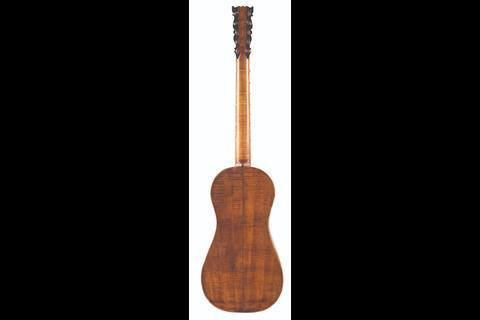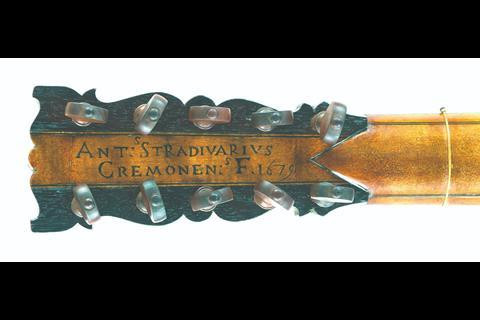By the late 17th century, the guitar enjoyed considerable popularity across Europe. Among the esteemed workshops crafting these instruments, those of Stradivari, Amati, and Guarneri in Cremona stood out. Of the few Stradivari guitars that have survived to this day – estimates suggest only five or six – the ‘Sabionari’ of 1679 holds a unique position. Thanks to a meticulous recent restoration, it is now the sole playable Stradivarius Guitar in existence. The opportunity to hear the authentic sound of an original Baroque guitar is exceptionally rare. It provides invaluable insights for scholars and musicians alike, deepening our understanding of Stradivari’s guitar-making philosophy and the performance practices of 18th-century music. Consequently, online recordings of the ‘Sabionari’ guitar’s sound are highly sought after by enthusiasts and researchers globally.
 Close-up of the ornate rosette and bridge of the Sabionari Stradivarius guitar
Close-up of the ornate rosette and bridge of the Sabionari Stradivarius guitar
Like all surviving Stradivari instruments, the ‘Sabionari’ guitar underwent modernization to adapt to evolving musical tastes and performance standards. In the early 19th century, it was transformed into a six-string guitar by the Ferrara-based Italian luthier Giuseppe Marconcini. This conversion involved significant alterations, including a new neck, peghead, and bridge. Marconcini also added new linings and braces to reinforce the structure. Remarkably, the original Stradivari nameplate was carefully preserved and reattached to the modified instrument, a testament to its enduring legacy. After approximately 150 years, the newer neck and peghead suffered from woodworm infestation. However, in a surprising turn of events, the insects spared the original soundboard and bracing crafted by Stradivari, possibly due to some form of wood treatment applied by the master luthier himself.
 Detailed view of the Sabionari Stradivarius guitar's body, showcasing the wood grain and purfling
Detailed view of the Sabionari Stradivarius guitar's body, showcasing the wood grain and purfling
The 2011 restoration, undertaken by Sinier de Ridder in France, was carried out with the utmost care and respect for the instrument’s historical integrity. Crucially, the body of the guitar was not opened during this process, preserving its delicate structure. Marconcini’s 19th-century neck and peghead, compromised by woodworm, were replaced with newly crafted components. These replacements were meticulously mounted on the original nails and conformed to the instrument’s original diapason, measuring 74cm. To complete the restoration and return the guitar to its likely Baroque-era appearance, a new bridge, rosette, and moustaches were created. These elements were carefully modeled after those found on the ‘Hill’ and ‘Giustiniani’ Stradivari guitars, ensuring stylistic consistency. Notably, two of the original tuning pegs were still usable and were reincorporated into the restored instrument. The intricate rosette was handcrafted by the skilled Milanese artisan Elena Dal Cortivo, adding a final touch of artistry to the restoration.
In 1948, the renowned Spanish virtuoso guitarist Andrés Segovia had the opportunity to examine the ‘Sabionari’ guitar. Evidently moved by the encounter with such a historic instrument, Segovia left his signature and a personal dedication to Stradivari on the guitar’s back, positioned just beneath the soundhole. This inscription serves as a further layer to the rich history of the ‘Sabionari’, connecting it to a pivotal figure in the 20th-century classical guitar world.
The ‘Sabionari’ Stradivarius guitar, a prized possession of the Museo del Violino in Cremona, stands as a remarkable testament to Antonio Stradivari’s genius and the enduring appeal of the guitar. Its unique playability after centuries makes it an invaluable resource for understanding both historical instrument making and Baroque musical performance. For those seeking to experience the sound of this exceptional instrument, recordings are available online, offering a virtual encounter with a truly rare piece of musical history.
(This article is based on information from the Tokyo Stradivarius Festival brochure and The Strad magazine.)
